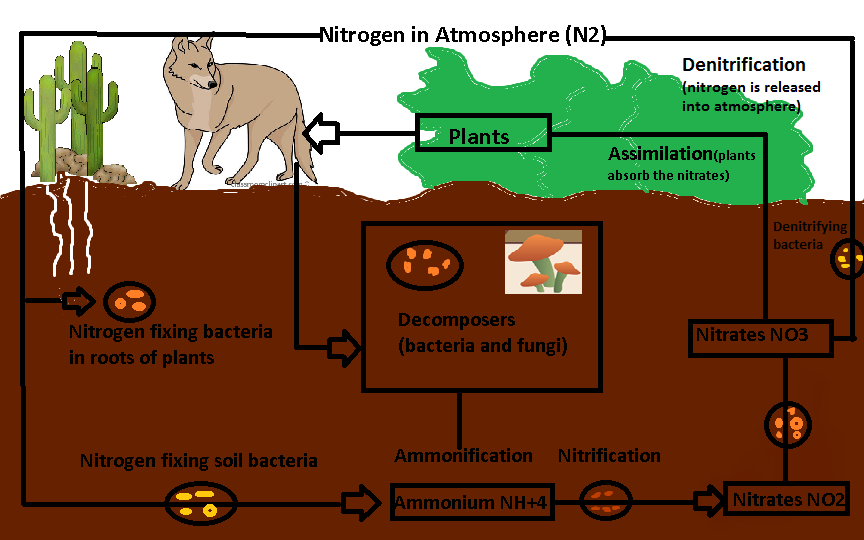Ecology Project- Deserts
Friday, January 29, 2016
Limiting factors- 2 density-dependent and 2 density-independent
Two things I discovered today about the desert is that it contains density-dependent and density-independent factors. 2 density-dependent factors in the desert are competition and disease. An example of competition would be the Cactus Wren population fighting for the same resources. They all receive food and water from the Saguaro Cactus, but the cactus can only provide so much for a large population of birds. The desert is a highly populated biome for some species, such as coyotes. Fleas and ticks can spread easily throughout the coyote population, and can cause sickness throughout the whole pack. 2 density-independent factors are limitation of water and the hot climate. There is less than 25 cm. of rainfall a year in the desert biome. For example, the Yucca plant has waxy leaves that help prevent transpiration. An example of animals being about to withstand the heat would be Gila Monsters. They are forced to stay under rocks until the sun goes down so their bodies do not over heat.
3 plants and a specific adaptation for survival for each plant
Three plants I've seen today are: the elephant tree, a saguaro, and a desert sage. These plants have special adaptations that allow them to live in these extreme desert climates. The elephant tree has long trunks that allow them to store water for days. The saguaro uses thorns to protect itself from predators. Also, the saguaro's flowers self pollinate very easily, ensuring that the cactus does not have to worry about extinction. The desert sage's adaption is that it does not need water at all; it can survive drought very well. Instead, it conserves solar energy instead of water like most plants.
3 animals and a specific adaptation for survival for each animal
The three animals I have seen so far are: jack rabbits, scorpions and coyotes.The jackrabbits have large eyes with specific placement. They are positioned closer to the end of their face, allowing them to see in front of as well as to the side of them. This helps keep them alert of any predators. Scorpions have a hard exoskeleton. They use it to prevent themselves from being easily crushed by larger objects. Also, their wax-like exoskeleton helps minimize water loss.The coyotes use their large muscles to help them run fast and catch their prey easier. They also use their sharp claws to rip apart their prey.
Thursday, January 28, 2016
3 Examples of competition
Today on my journey through the desert biome I learned all about the competition that goes on in the desert biome. Here are some examples: An eagle and rattlesnakes fighting for birds to eat, coyote and rattlesnake fighting over a pocket mouse, and cacti fighting for water with all other organisms.
5 Specific Sources
http://www.ucmp.berkeley.edu/exhibits/biomes/deserts.php
http://www.blueplanetbiomes.org/desert.htm
http://environment.nationalgeographic.com/environment/habitats/desert-threats/
http://desertfactbook.weebly.com/competition.html
http://desertbiomepro.weebly.com/symbioticcompetitive-relationships.html
http://www.blueplanetbiomes.org/desert.htm
http://environment.nationalgeographic.com/environment/habitats/desert-threats/
http://desertfactbook.weebly.com/competition.html
http://desertbiomepro.weebly.com/symbioticcompetitive-relationships.html
Nitrogen Cycle
 Today I learned all about the nitrogen cycle in the desert biome and this is what i learned. A basic example of the nitrogen cycle in a desert biome begins with the uptake of nitrates by desert plants. The plants that contain the nitrate are then consumed by insects and and reptiles. These primary consumers are then eaten by secondary consumers, transferring the nitrates from the primary consumers to the secondary consumers. The nitrogen-bearing compounds in these animals are passed further up the food chain to larger carnivores such as coyotes and birds of prey. These carnivores are at the top of their food chains and when they die the nitrogen is returned to the soil. Finally back to soil, bacteria and fungi mineralize the nitrogen back to a usable state for plants. Bringing the cycle back to the beginning.
Today I learned all about the nitrogen cycle in the desert biome and this is what i learned. A basic example of the nitrogen cycle in a desert biome begins with the uptake of nitrates by desert plants. The plants that contain the nitrate are then consumed by insects and and reptiles. These primary consumers are then eaten by secondary consumers, transferring the nitrates from the primary consumers to the secondary consumers. The nitrogen-bearing compounds in these animals are passed further up the food chain to larger carnivores such as coyotes and birds of prey. These carnivores are at the top of their food chains and when they die the nitrogen is returned to the soil. Finally back to soil, bacteria and fungi mineralize the nitrogen back to a usable state for plants. Bringing the cycle back to the beginning.
Subscribe to:
Comments (Atom)
